The Bajocian
The Bajocian Age of the Middle Jurassic Epoch: 171.6 to 167.7 million years ago
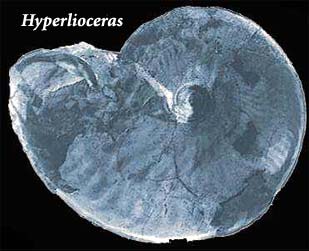 The Bajocian Age was originally supposed to be the lowest one third of the "Oolite" (Middle Jurassic). Thus it was first referred to, by William Smith, no less, as the "Under Oolite." (Later the business of naming strata fell into the hands of persons who disapproved of Anglo-Saxonisms, and it became the "Inferior Oolite.") As often happens in geology, this naive first intention was corrupted by other, equally well-intentioned, folk trying to square the original intention with new data. The three parts of the original Middle Jurassic Series are no longer of exactly equal size, and it became necessary to squeeze a fourth "third" (the Aalenian) between the Bajocian and the Toarcian. As currently defined, the Bajocian begins at the level where the ammonite Hyperlioceras replaces the Aalenian Lioceras near the old lighthouse of Cabo Mondego, on the Atlantic coast of Portugal, not far from Figueira da Foz and the ancient pre-Roman!) university town of Coimbra.
The Bajocian Age was originally supposed to be the lowest one third of the "Oolite" (Middle Jurassic). Thus it was first referred to, by William Smith, no less, as the "Under Oolite." (Later the business of naming strata fell into the hands of persons who disapproved of Anglo-Saxonisms, and it became the "Inferior Oolite.") As often happens in geology, this naive first intention was corrupted by other, equally well-intentioned, folk trying to square the original intention with new data. The three parts of the original Middle Jurassic Series are no longer of exactly equal size, and it became necessary to squeeze a fourth "third" (the Aalenian) between the Bajocian and the Toarcian. As currently defined, the Bajocian begins at the level where the ammonite Hyperlioceras replaces the Aalenian Lioceras near the old lighthouse of Cabo Mondego, on the Atlantic coast of Portugal, not far from Figueira da Foz and the ancient pre-Roman!) university town of Coimbra.
The Bajocian marks the opening of the South Atlantic, at least so we are told. If this were actually the case, there would be no Aalenian ammonites at Cabo Mondego. Probably what is intended is that the Bajocian marks the first period during which the North American and African cratons were separated by a measureable amount of deep-ocean crust. The South Atlantic itself was already perhaps 500 km wide, a long arm of the Tethys reaching southwest from Central Europe (since much of southern Europe was still part of Africa). See the Middle Jurassic map. In North  America, the Sundance Sea covered large parts of the American and Canadian West. That region was also subject to ocasional large volcanic eruptions, as small terranes sutured themselves to the west coast from Southern California to Alaska.
America, the Sundance Sea covered large parts of the American and Canadian West. That region was also subject to ocasional large volcanic eruptions, as small terranes sutured themselves to the west coast from Southern California to Alaska.
Bivalves and brachiopods were both present in large numbers (together with the inevitable ammonites and belemnites) abundance around the reefs. These reefs were of the Early Mesozoic type in which scleractinian corals grew on a framework filled in by calcareous sponges. These probably looked much more like modern reefs than the rudist-dominated reefs of the later Mesozoic. Crinoids were still an important part of the fauna, although far less so than in Paleozoic times. Infaunal crustaceans shared the benthic domain with bivalves as they do today. The large marine fauna, by contrast, would have been rather strange. It included a mixture of early teleosts with many surviving non-teleosts, modern (Neoselachian) sharks, but also numerous ichthyosaurs and plesiosaurs. The seas were also "greener" than they are today, i.e. the green algae chlorophyll b-based life dominated over the red algae and chlorophyll c-based autotrophs. So, for example, the first tentatively planktonic foraminifera were just beginning to appear during the Bajocian.
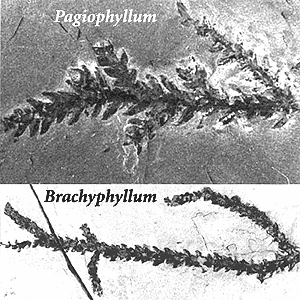 On land, the vegetation generally consisted of conifers, cycads, ginkgos, ferns and horsetails. Many of the most familiar insect orders of today had not yet evolved, e.g., ants, termites and advanced roaches. On the other hand paleopterans -- dragonflies and their cousins -- were far more common. Since there were as yet no birds, flying insect predators were probably much more common. Small mammaliformes also helped control the insect population. The dinosaurs already dominated the large terrestrial niches. Cetiosaurus and Rhoetosaurus show the increasing importance of sauropods, while Lufengosaurus was one of the last of the prosauropods. Basal coelurosaurs were common theropods.
On land, the vegetation generally consisted of conifers, cycads, ginkgos, ferns and horsetails. Many of the most familiar insect orders of today had not yet evolved, e.g., ants, termites and advanced roaches. On the other hand paleopterans -- dragonflies and their cousins -- were far more common. Since there were as yet no birds, flying insect predators were probably much more common. Small mammaliformes also helped control the insect population. The dinosaurs already dominated the large terrestrial niches. Cetiosaurus and Rhoetosaurus show the increasing importance of sauropods, while Lufengosaurus was one of the last of the prosauropods. Basal coelurosaurs were common theropods.
Image credit: (a) Hyperlioceras from Echinologia. (b) Cetiosaurus from Yahoo! Pagiophyllum and Brachyphyllum conifers) from Cornet & McDonald 1995) [1].
Links: DinoData Timeperiods Bajocian, Aalenian - Bajocian - GCR block, EARLY STRATIGRAPHIC RECORD AND MAJOR EVOLUTIONARY CHANGES OF THE ..., Image catalog, Bajocian to Oxfordian palynology of the Poland, My Fossils from Figueira da Foz, Radiolaria and Geological Age, Ammonites stratotyp stratotype bajocien bajocian.
ATW041107. Text public domain. No rights reserved.
Bajocian Life
Other Invertebrates
As usual, annelid fossils are rarer than galliform molars. However, Bajocian sediments frequently bear the long, narrow, slightly curved, and sometimes branched borings known as Trypanites. These are generally attributed to polychaete predators.
Typical Bajocian brachiopods are various species of the genera Acanthothyris and Sphaeroidothyris. The two in the image are actually Bathonian, but we're hoping you can't tell the difference.
Tethyan brachiopods suffered near extinction at the end of the Pleinsbachian in the Early Jurassic. In the early Bajocian, brachiopods recovered most of this lost diversity, only to lose most of their gains towards the end of Bajocian. This cycle of boom and bust characterizes Mesozoic brachiopods. Bivalves show similar cycles, but the changes are not as dramatic. Ruban 2004). Consequently, the bivalves had greater genetic resources to call on at the beginning of each cycle, and so gained steadily on brachiopods over the course of the next hundred million years.
 As an aside, we occasionally wonder about the actual synchrony of these events on a worldwide scale. Who ordered this? Do we really need to invoke the invisible hand of mass extinction to explain anything here? Brachiopods evolved to fill a particular niche. They were, and are, suspension feeders specialized for areas of clear water, relatively low-energy, and stable substrates. Given those conditions, they are spectacular at turning detritus into biomass and are relatively impervious to the perils of depth, temperature, and predation. The brachiopod minimum daily requirements were very common in the Cambrian, reasonably common in the Ordovician, and relatively less common in the Mesozoic -- particularly in the heavily studied Tethyan area.
As an aside, we occasionally wonder about the actual synchrony of these events on a worldwide scale. Who ordered this? Do we really need to invoke the invisible hand of mass extinction to explain anything here? Brachiopods evolved to fill a particular niche. They were, and are, suspension feeders specialized for areas of clear water, relatively low-energy, and stable substrates. Given those conditions, they are spectacular at turning detritus into biomass and are relatively impervious to the perils of depth, temperature, and predation. The brachiopod minimum daily requirements were very common in the Cambrian, reasonably common in the Ordovician, and relatively less common in the Mesozoic -- particularly in the heavily studied Tethyan area.
Mass extinction studies are normally done with a maximum resolution of
±1 My. In fact, we can't usually be much more precise than that for any event in the Jurassic. But all that's required for a global "mass extinction" is a single year with some combination of serious volcanoes, a few monster storms and some toxic algal blooms. Unlikely? Sure, but a lot can happen in two million years. Our idea of what is "likely," based on our own miniscule life span, really isn't a consideration. At least on a local level, "mass extinctions" probably happen every few centuries. If bivalves had had even the slightest long-term genetic advantage over brachiopods in responding to such events, the entire taxon would, in geological terms, have vanished faster than an assistant prof. with a two-year grant to study body-surfing in Hawaii.
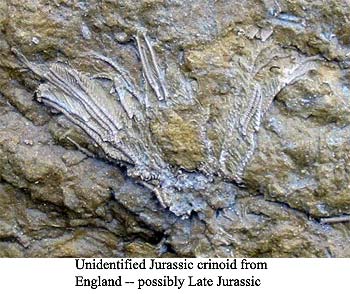 For long-term, incremental faunal changes, we need to look for long-term, incremental environmental changes. The environmental factors needed for a happy brachiopod are well-understood. The reduced availability of those factors in the Mesozoic is likewise well understood. Why, in the name of Bill Occam's long mustache, do we need to invoke some pointlessly convoluted genetic explanation? Brachiopods don't suffer from "racial senescence," moral decadence, or a wasting disease. In their own part of ecospace, they can still lick any bivalve in the house with one lophophore tied behind their backs (if they had backs, that is). Their only problem is that, like a lot of the stratigraphers who study brachiopods, they're well-qualified specialists in a field that simply has fewer openings than it used to have.
For long-term, incremental faunal changes, we need to look for long-term, incremental environmental changes. The environmental factors needed for a happy brachiopod are well-understood. The reduced availability of those factors in the Mesozoic is likewise well understood. Why, in the name of Bill Occam's long mustache, do we need to invoke some pointlessly convoluted genetic explanation? Brachiopods don't suffer from "racial senescence," moral decadence, or a wasting disease. In their own part of ecospace, they can still lick any bivalve in the house with one lophophore tied behind their backs (if they had backs, that is). Their only problem is that, like a lot of the stratigraphers who study brachiopods, they're well-qualified specialists in a field that simply has fewer openings than it used to have.
Scleractinian corals peaked as reef builders during the Bajocian or somewhat later, depending on exact location. After this point, the rising seas began to drown the carbonate platforms around the Tethys which were their normal habitat. However, in the Bajocian, coral reefs were thriving even in areas well outside the tropics, from the Paris Basin all the way south to Tanzania, as marine conditions invaded the growing gap between Africa and East Gondwana Madagascar, India and Antarctica). The coral belt also stretched from Iberia east to at least Kazakhstan and presumably China. For some reason, corals are very rare along the west coast of North America at this time, even in the warm, shallow waters of the Sundance Sea.
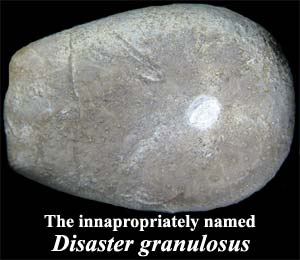 The Bajocian marked a turning point for two large taxa of echinoderms. For the crinoids, it was virtually the last age in which stalked crinoids contested for dominance of shallow-water habitats. Radwanska & Radwanski (2003) report that the Bajocian 1-2 cm diameter North European "stalk ossicles" known as Cyclocrinus are actually the branched roots of some monster crinoid whose exposed parts have never been identified. They speculate that storms of unusual size may have been responsible for decimating these populations. We note, in addition, recent evidence that a lower mantle plume was tossing the Arabian plate around at the time. Magmatic inclusions all over eastern Eurasia show the strains this was putting on the neighborhood. These data have special interest for the preceding discussion of brachiopods. At any event, these last shallow-water crinoid communities were replaced by bivalves at the end of Bajocian time.
The Bajocian marked a turning point for two large taxa of echinoderms. For the crinoids, it was virtually the last age in which stalked crinoids contested for dominance of shallow-water habitats. Radwanska & Radwanski (2003) report that the Bajocian 1-2 cm diameter North European "stalk ossicles" known as Cyclocrinus are actually the branched roots of some monster crinoid whose exposed parts have never been identified. They speculate that storms of unusual size may have been responsible for decimating these populations. We note, in addition, recent evidence that a lower mantle plume was tossing the Arabian plate around at the time. Magmatic inclusions all over eastern Eurasia show the strains this was putting on the neighborhood. These data have special interest for the preceding discussion of brachiopods. At any event, these last shallow-water crinoid communities were replaced by bivalves at the end of Bajocian time.
For the heart urchins, the Bajocian was the beginning of a period of major renewal. After near-extinction at the end of the Permian, the Irregularia had puttered along, and a handful of rare species are known from the Triassic and Early Jurassic. In the Middle Jurassic, the dominant, and perhaps sole, genus bore the inauspicious name of Disaster. Notwithstanding the name, Disaster was a great success. It soon diversified into a number of new forms, which gave rise two whole new orders in the Neocomian: the Holasteroidea and the Spatangoida. Eble 1999).
The usual doctrine for the Mesozoic is that Triassic sponge reefs were replaced by the "advanced" scleractinian corals. In the Middle Jurassic, that order was actually reversed. The Bajocian marine transgression (a time when the sea rose to cover previously dry land) was the first step in the drowning of the marine carbonate platforms on which the corals grew. As the waters rose, the coral reefs grew further from their optimum level of sunlight. Coral growth slowed down. As the corals began to grow less aggressively, hexactinellid and lithistid sponges began to reappear, forming mixed sponge-coral reefs. This was a pattern seen all over western Europe in the Bajocian and subsequently elsewhere.
Image Credits: Trypanites from Urme Fosile (Dr. Sorin Filipescu, Univ. Babes-Bolyai, Romania), adapted from Benton & Harper (1997). Acanthothyris and Sphaeroidothyris from The Jurassic Fossil Room. Crinoid from Discovering Fossils. Disaster from the Natural History Museum's Echinoid Directory.
Links: CHECKLIST OF Jurassic BRYOZOANS; Burton Bradstock - Geology Field Trip Guide
ATW041109. Text public domain. No rights reserved.
page uploaded on Palaeos Site 9 April 2002, last modified 28 June
checked ATW030912
 The Bajocian Age was originally supposed to be the lowest one third of the "Oolite" (Middle Jurassic). Thus it was first referred to, by William Smith, no less, as the "Under Oolite." (Later the business of naming strata fell into the hands of persons who disapproved of Anglo-Saxonisms, and it became the "Inferior Oolite.") As often happens in geology, this naive first intention was corrupted by other, equally well-intentioned, folk trying to square the original intention with new data. The three parts of the original Middle Jurassic Series are no longer of exactly equal size, and it became necessary to squeeze a fourth "third" (the Aalenian) between the Bajocian and the Toarcian. As currently defined, the Bajocian begins at the level where the ammonite Hyperlioceras replaces the Aalenian Lioceras near the old lighthouse of Cabo Mondego, on the Atlantic coast of Portugal, not far from Figueira da Foz and the ancient pre-Roman!) university town of Coimbra.
The Bajocian Age was originally supposed to be the lowest one third of the "Oolite" (Middle Jurassic). Thus it was first referred to, by William Smith, no less, as the "Under Oolite." (Later the business of naming strata fell into the hands of persons who disapproved of Anglo-Saxonisms, and it became the "Inferior Oolite.") As often happens in geology, this naive first intention was corrupted by other, equally well-intentioned, folk trying to square the original intention with new data. The three parts of the original Middle Jurassic Series are no longer of exactly equal size, and it became necessary to squeeze a fourth "third" (the Aalenian) between the Bajocian and the Toarcian. As currently defined, the Bajocian begins at the level where the ammonite Hyperlioceras replaces the Aalenian Lioceras near the old lighthouse of Cabo Mondego, on the Atlantic coast of Portugal, not far from Figueira da Foz and the ancient pre-Roman!) university town of Coimbra.

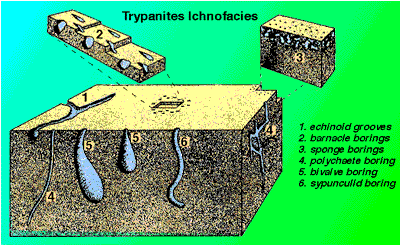 Annelida
Annelida


